
Quilting is the term given to the process of joining a minimum of three layers of fabric together either through stitching manually using a needle and thread, or mechanically with a sewing machine or specialised longarm quilting system. An array of stitches is passed through all layers of the fabric to create a three-dimensional padded surface. The three layers are typically referred to as the top fabric or quilt top, batting or insulating material, and the backing.

The Grapes of Wrath is an American realist novel written by John Steinbeck and published in 1939. The book won the National Book Award and Pulitzer Prize for fiction, and it was cited prominently when Steinbeck was awarded the Nobel Prize in Literature in 1962.

Patchwork or "pieced work" is a form of needlework that involves sewing together pieces of fabric into a larger design. The larger design is usually based on repeating patterns built up with different fabric shapes. These shapes are carefully measured and cut, basic geometric shapes making them easy to piece together.

A quilt is a multi-layered textile, traditionally composed of two or more layers of fabric or fiber. Commonly three layers are used with a filler material. These layers traditionally include a woven cloth top, a layer of batting or wadding, and a woven back combined using the techniques of quilting. This is the process of sewing on the face of the fabric, and not just the edges, to combine the three layers together to reinforce the material. Stitching patterns can be a decorative element. A single piece of fabric can be used for the top of a quilt, but in many cases the top is created from smaller fabric pieces joined, or patchwork. The pattern and color of these pieces creates the design.
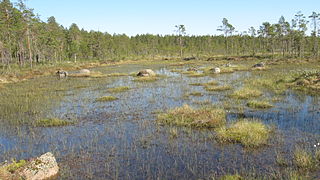
A bog or bogland is a wetland that accumulates peat as a deposit of dead plant materials – often mosses, typically sphagnum moss. It is one of the four main types of wetlands. Other names for bogs include mire, mosses, quagmire, and muskeg; alkaline mires are called fens. A bayhead is another type of bog found in the forest of the Gulf Coast states in the United States. They are often covered in heath or heather shrubs rooted in the sphagnum moss and peat. The gradual accumulation of decayed plant material in a bog functions as a carbon sink.

Felt is a textile that is produced by matting, condensing, and pressing fibers together. Felt can be made of natural fibers such as wool or animal fur, or from synthetic fibers such as petroleum-based acrylic or acrylonitrile or wood pulp–based rayon. Blended fibers are also common. Natural fibre felt has special properties that allow it to be used for a wide variety of purposes. It is "fire-retardant and self-extinguishing; it dampens vibration and absorbs sound; and it can hold large amounts of fluid without feeling wet..."
A pearl is a hard object produced by mollusks.

Bedding, also called bedclothes or bed linen, is the materials laid above the mattress of a bed for hygiene, warmth, protection of the mattress, and decorative effect. Bedding is the removable and washable portion of a human sleeping environment. Multiple sets of bedding for each bed are often washed in rotation and/or changed seasonally to improve sleep comfort at varying room temperatures. Most standardized measurements for bedding are rectangular, but there are also some square-shaped sizes, which allows the user to put on bedding without having to consider its lengthwise orientation.
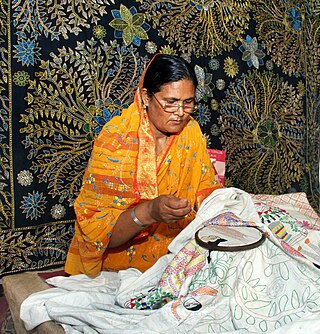
Kantha, also spelled kanta or qanta, is a type of embroidery craft in Bangladesh and eastern regions of India, particularly in the Indian states of West Bengal, Tripura and Odisha. In Odisha, old saris are stacked on each other and hand-stitched to make a thin piece of cushion. This is normally used above a bed cushion or instead of a cushion. "Kantha saris" are traditionally worn by women in Bengal region. In these days, embroidery is stitched, popularly known as 'kantha stitched", on sari, kurta and churidar and many other garments and gaining popularity due to their aesthetic value and handmade characteristics.

A shawl is a simple item of clothing, loosely worn over the shoulders, upper body and arms, and sometimes also over the head. It is usually a rectangular piece of cloth, but can also be square or triangular in shape. Other shapes include oblong shawls. It is associated with the inhabitants of the northern Indian subcontinent—particularly Kashmir and Punjab—and Central Asia, but can be found in many other parts of the world.
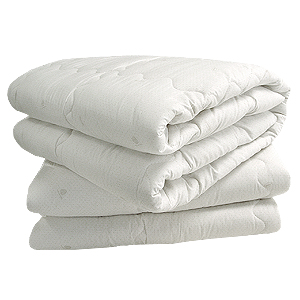
A comforter, also known as a doona in Australian English, or a continental quilt or duvet in British English, is a type of bedding made of two lengths of fabric or covering sewn together and filled with insulative materials for warmth, traditionally down or feathers, wool or cotton batting, silk, or polyester and other down alternative fibers. Like quilts, comforters are generally laid over a top bed sheet and used to cover the body during sleep. Duvets are another form of quilt, traditionally filled with feathers, though since the late 20th century often made of synthetic fibres or down alternatives.
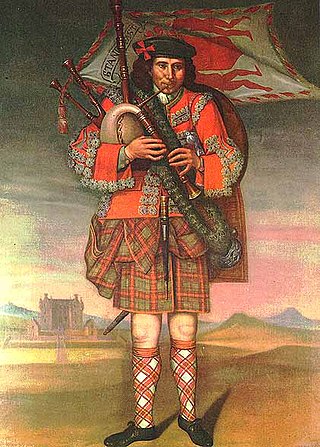
The belted plaid is a large blanket-like piece of fabric which is wrapped around the body with the material pleated or, more accurately, loosely gathered and secured at the waist by means of a belt. Typically, a portion of the belted plaid hangs down to about the knees or ankles with the rest of the material being wrapped up around the upper body in a variety of ways and pinned or otherwise secured to keep it in place.
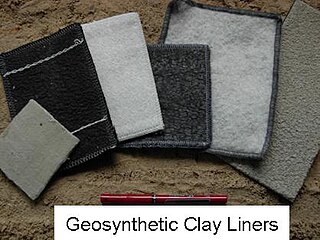
Geosynthetic clay liners (GCLs) are factory manufactured hydraulic barriers consisting of a layer of bentonite or other very low-permeability material supported by geotextiles and/or geomembranes, mechanically held together by needling, stitching, or chemical adhesives. Due to environmental laws, any seepage from landfills must be collected and properly disposed of, otherwise contamination of the surrounding ground water could cause major environmental and/or ecological problems. The lower the hydraulic conductivity the more effective the GCL will be at retaining seepage inside of the landfill. Bentonite composed predominantly (>70%) of montmorillonite or other expansive clays, are preferred and most commonly used in GCLs. A general GCL construction would consist of two layers of geosynthetics stitched together enclosing a layer of natural or processed sodium bentonite. Typically, woven and/or non-woven textile geosynthetics are used, however polyethylene or geomembrane layers or geogrid geotextiles materials have also been incorporated into the design or in place of a textile layer to increase strength. GCLs are produced by several large companies in North America, Europe, and Asia. The United States Environmental Protection Agency currently regulates landfill construction and design in the US through several legislations.

A woobie, is a piece of field gear originating in the United States military that can be attached to a standard issue poncho to provide additional warmth, as well as being usable as a blanket, sleeping bag or protective cover. It consists of quilted nylon with a polyester filling. It is attached to the poncho by means of integral lengths of material which are looped through the poncho's eyelets.
The mosaic theory in finance involves the use of security analyst personnel to gather information about a company or corporation to evaluate and determine its financial stability. In addition to public information available to all investors, securities analysts also have access to non-public information which the vast majority of investors do not possess. Trading based on such non-public information can be considered illegal if the information is also material, as defined by insider trading laws.
Beast most often refers to:

Manure is organic matter that is used as organic fertilizer in agriculture. Most manure consists of animal feces; other sources include compost and green manure. Manures contribute to the fertility of soil by adding organic matter and nutrients, such as nitrogen, that are utilised by bacteria, fungi and other organisms in the soil. Higher organisms then feed on the fungi and bacteria in a chain of life that comprises the soil food web.
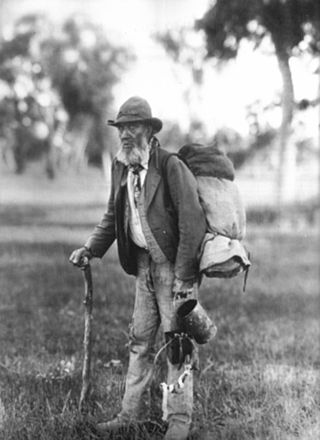
The cowboy bedroll was an American Old West precursor to the modern sleeping bag, which carried a man's bed and some personal belongings in a waterproof shell. In Australia, it was called a swag.














